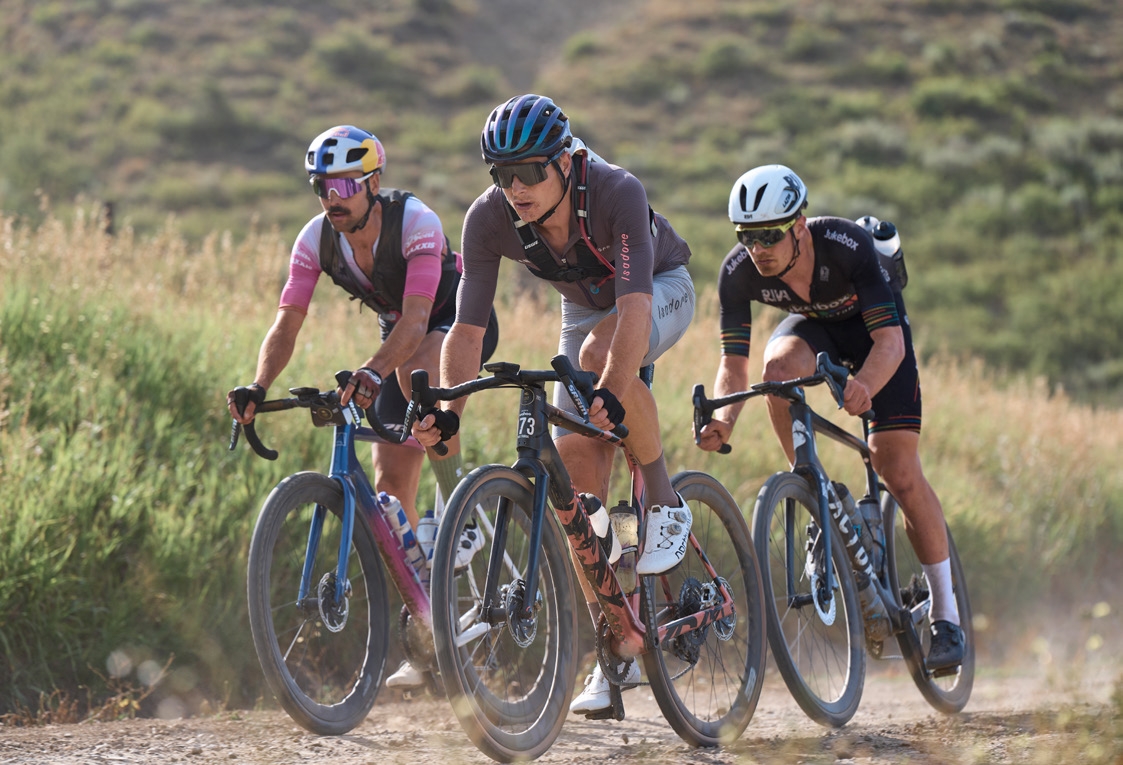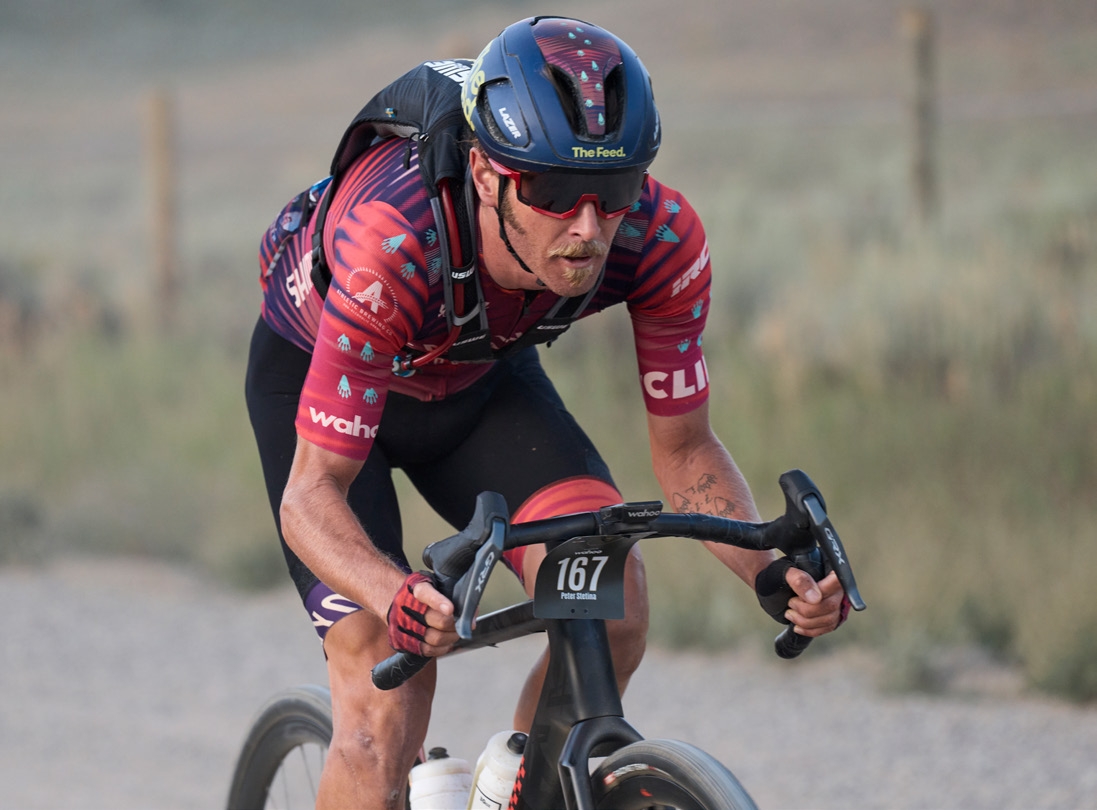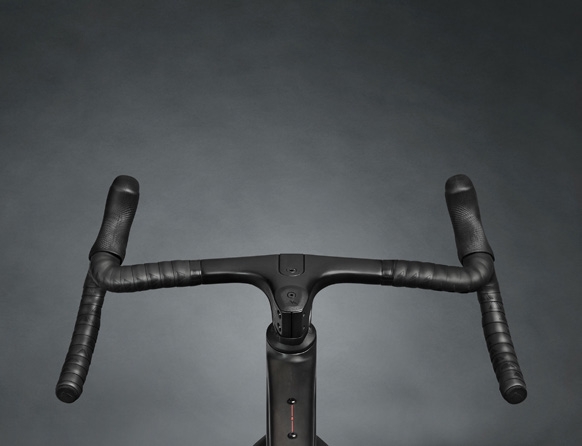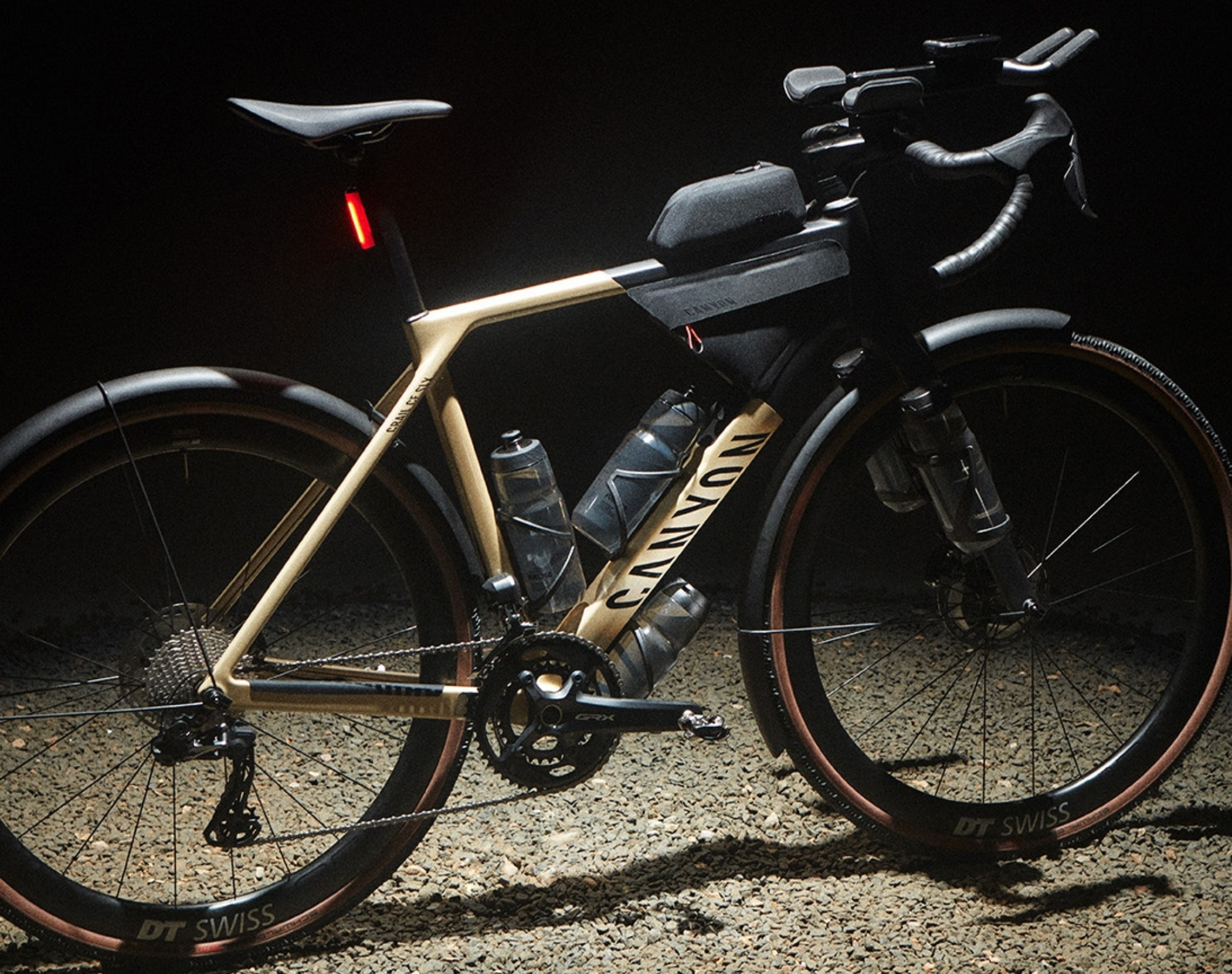UCI Gravel Champs winning bike now launched: Canyon unveils the new Grail
Integration and aerodynamics have been the focus


Canyon’s update to its Grail gravel bike has been a long time coming. The bike broke cover back in May when Tiffany Cromwell piloted it to victory in the UK’s first UCI-level gravel race. The Grail surfaced again in the 2023 edition of Unbound, with Carolin Schiff and Tiffany Cromwell winning the Unbound 200 and 100 races, respectively.
And, of course, Kasia Niewiadoma cinched the UCI Gravel World Champs in Treviso, Italy, aboard the new Grail.
As such, the biggest changes (tweaks to the tube shapes and the ditching of the Double Decker Bar in favor of a more traditional bar/stem/steerer tube) are hardly a surprise. Still, there’s a lot of neat details and hearing Canyon’s reasons behind its design choices is quite interesting in itself.
But first, let’s quickly recap where the Grail stands in Canyon’s range and what the German brand believes the purpose of this model is. With Canyon having launched the burly and mount bedecked Grizl gravel bike back in May 2021, the Grail’s position in the range actually became rather clearer: part way between the Endurace road bike and Grizl adventure bike, it’s a model which balanced speed with off-road capability.

With this latest iteration, Canyon has sought to really hone the Grail for the gravel racing scene. That means there are some features and details which most amateur rider won’t reap the full benefits of. For instance, there’s the compatibility with 52/36t chainrings, which is far beyond what most people would need on a gravel bike.
On the other hand, many of the features which make a good gravel race bike (integrated storage, light weight, sprightly but controlled handling) are ones which all of us can enjoy. So, let’s hop into the details and dig into what Canyon has been doing with the Grail.
Aerodynamics

As mentioned, a large focus of the new Grail is on gravel racing performance and, as such, aerodynamics have been a key consideration. To illustrate, Canyon’s rider Petr Vakoc held an average speed of 38 kph over 227 km in the 2023 edition of SBT GRVL. If you try seeing how long you can hold 38 kph for, it’ll be clear pretty quickly just how fast that speed is - even on tarmac!
The latest race content, interviews, features, reviews and expert buying guides, direct to your inbox!
With this in mind, Canyon has devoted a lot of research and development to improving the aerodynamics of the Grail. It is true that the overwhelming majority of Grail riders won’t be reaping quite as much benefit from any aero improvements as those sitting at the pointy end of gravel racing. But Canyon needs to provide a bike which does the job for its sponsored athletes, and that means saving those grams of drag wherever possible - even if that is a little superfluous for a portion of the wider user base.

Now, actions speak louder than words, and I for one am very glad Canyon has decided to backtrack on the Double Decker Handlebars that were a feature of the previous Grail. I found the junction jutting out the side of the drops made it much more difficult to switch between the hoods and the drops. My thumbs would get caught up on it every time. It was also a shame not to be able to fit a set of aero bars, or even simply swapping in a different set of handlebars.
It is quite interesting to note that the reason which Canyon is choosing to focus on for the change is the aerodynamic performance. The Double Decker Bar (quite understandably) produces more drag with its two leading edges than a typical handlebar with a single leading edge. Still, no matter where the emphasis is placed, this switch to a more traditional bar/stem/steerer design remains very much appreciated.

All together, the adjustments to the tube shapes, the D-shaped seatpost, the new ‘Double Drop Bar’ and the semi-integrated cables have resulted in a claimed watt saving of 9.1 at 45 kph, compared to the previous Grail with the same specs - a pretty sizable improvement.
Like a growing number of Gravel bikes, the new Grail also features in-frame storage. It’s nice making use of that otherwise dead space inside the frame - plus it means that your tools are quickly accessible and it streamlines the bike to some degree. But what’s quite fun is that the Canyon’s partial frame bag designed specifically for the Grial (the Load Fidlock Quickloader) actually makes the bike 1.5 watts faster with it mounted than without - essentially acting as a faring.
Bars and seatpost

It’s worth paying a bit more attention to the handlebars, as Canyon has put a lot of work into them and there’s some really notable features. First off, Canyon has integrated a ‘Gear Groove’, which allows for a wide range of accessories. You can use it to mount your bike computer, an SP Connect phone mount, your bike lights or Go Pro - or even a set of aero extensions, which is very neat for a one-piece aero handlebar.
Curiously, the handlebars have a combination of 5 degrees of backsweep (meaning the bars end up a little closer to your body), as well as an extension to the curve of the bars behind the hoods, where the tops start to transition to the drops. You might think that this pairing would leave the actual lever hoods in pretty much the same position - and so what’s the point? But the idea is holding onto the curve of the bars (which many people end up doing anyway) becomes a more comfortable position in its own right.

Canyon has also flared out the handlebars by 5 degrees at the hoods for extra stability there - with this splaying out even further to 16 degrees down at the drops.
There is some variance between the ‘standard’ bars (the CP0039) and the model which Canyon has developed for the pros (the CP0047) - although you can buy the pro version aftermarket. The CP0039 has a subtle negative angle across the tops and has widths between 420 and 460mm.
The CP0047 has a more extreme negative angle across the tops, replicating a more negatively angled stem - equivalent to 15mm of drop. It also has a narrower 400mm width and longer stem lengths of between 80 and 110mm.

Coming now to the seatpost, with a move from a round seat tube to a D-shaped one for aerodynamics, the S15 VCLS 2.0 leaf-spring suspension seatpost sadly no longer fits. However, Canyon has worked to make the carbon seatpost for the new Grail competitively compliant. It offers much more flex than the seatpost used on the Canyon Ultimate road bike - naturally it’s not as compliant as the leaf-spring suspension seatpost, but it saves over 40 grams. Canyon’s detailed the deflection at the minimum insertion length to put some hard numbers on it
| Seatpost | Weight | Deflection at the min. insertion length |
|---|---|---|
| SP0055 (Ultimate) | 166g | 177 N/mm |
| SP0072 Comfortpost (Grail) | 203g | 69 N/mm |
| S15 VCLS 2.0 | 245g | 50 N/mm |
Geometry

Canyon’s goal with the new Grail was to increase the stability whilst also not compromising on the previous Grail’s agility. The main changes have been a lengthening of the wheelbase, as well as Canyon also trying to keep the trail value as close to 69mm as possible across most of the sizes, to keep the steering response constant for riders of varying heights.
Interestingly, the wheelbase increase is all at the front. The chainstays are 425mm for both the new Grail and the previous iteration, but whilst the old Grail had a full length of 1020mm, that’s now gone out to 1034mm in a size small. The head tube has also been steepened up a little on the size small, previously standing at 71 degrees, it’s now 71.5. I’ll discuss what these changes have done to the feel of the bike later on in my first ride review.
Features

Starting with the tire clearance, this is a little narrow at 42mm - but in the context of gravel race bikes, it is pretty close to the typical 45mm of clearance we generally see. It’s worth noting that Canyon does not recommend swapping between 650b and 700c wheelsizes with the grail
Coming to the chainring clearance, by keeping the tires slightly skinnier, there’s room on the Grail for fitting a pair of 52/36t chainrings - much larger than what most people use on gravel (larger even than what most people use on an endurance road bike). But this is again a design aspect for the pros - with the speeds that gravel races can hit, compatibility with rings that size is helpful.
Coming to the mounting point , there’s top tube bosses for a frame bag and under-downtube mounts for a third bottle cage. Although there aren’t triple (or even double) bosses on the fork legs for cargo cages, Canyon does offer a clever Load Fork Sleeve, which allows you to attach additional cages to the fork legs - whether that’s cargo or simply for water. The load rating is 3kg per size, which is pretty good considering.
There aren’t pannier mounts, although on a bike such as this we wouldn’t really expect them. On the other hand, there is compatibility with mudguards/fenders, and Canyon has developed its Defend Fast Fenders to be fast to mount and remove - and to work with up to 42mm tires, which is good to see.
First ride

I have to say, I did really enjoy the ride of the previous iteration of the Grail, I thought the handling and it was a whole barrel of fun when locked in the drops - it was just the Double Decker Bar which was such a major sticking point.
With that being the context, I was a little ambivalent on my first hearing of the tweaks to the geometry and particularly the lengthening of the wheelbase for stability. My question was: isn’t that what the Grizl is for? Why not leave the Grail with its more playful ride? But as I found out more about the details (and on my first actual ride of the bike!) my worries were all (mostly) allayed.
Often when a bike’s wheelbase is increased, this is done through a combination of lengthening the chainstays, increasing the front center and slackening out the head angle. But with the new Grail (in a size small), the chainstays have been kept the same at 425mm and the head angle has even been made half a degree steeper - despite the wheelbase going out from 1020mm to 1034mm.
Canyon calls the new geometry ‘cruise control handling’ and characterizes the cornering as ‘carving’. The Grail certainly does feel more stable than the previous iteration, but I think those descriptions don’t put enough emphasis on how lively the Grail still feels - it’s still got that agility through the corners and capacity for quick line changes on rocky descents. The Grail certainly isn’t confined to long-distance-trucking on straight and wide doubletrack.

Regarding the seatpost, I was pretty impressed by how much flex Canyon has managed to engineer into it. It still doesn’t top the Cervélo R5 (which has the flexiest ‘fixed’ seatpost I’ve seen) but it isn’t too far off, and does visibly bend when you rest your elbow on the saddle. It does a good job of sounding out the chatter and taking the edge off larger hits (up to a point). It simply isn’t the same as the S15 VCLS 2.0 leaf spring suspension seatpost, but it still does a good job - not a bad trade for the weight savings and claimed aero gains.
I’ll be continuing to put in the miles over the coming weeks and follow up with the full review
The CFR, the CF SLX, and the CF SL
As with other Canyon model ranges, there is also a CFR version of the new Grail. This offers the same features, but makes significant changes to the carbon layup. The frame and fork are 118g lighter whilst the bottom bracket and head tube have been made 10% stiffer. The fork’s lateral and frontal stiffness has also been increased by 4.5%.
There is also the CF SL, which is Canyon’s entry level model and forgoes a few of the features and integrations of the higher end models. Most notably, it loses the downtube storage and the ‘gear groove’ on the handlebars.
For more information on all the models, you can check out the new Grail range on Canyon’s website here.

After winning the 2019 National Single-Speed Cross-Country Mountain Biking Championships and claiming the plushie unicorn (true story), Stefan swapped the flat-bars for drop-bars and has never looked back.
Since then, he’s earnt his 2ⁿᵈ cat racing licence in his first season racing as a third, completed the South Downs Double in under 20 hours and Everested in under 12.
But his favourite rides are multiday bikepacking trips, with all the huge amount of cycling tech and long days spent exploring new roads and trails - as well as histories and cultures. Most recently, he’s spent two weeks riding from Budapest into the mountains of Slovakia.
Height: 177cm
Weight: 67–69kg